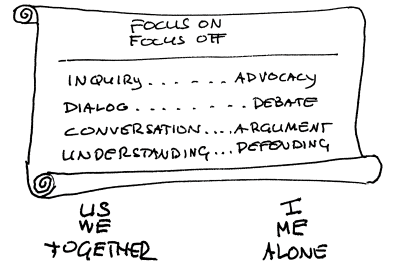Difference between revisions of "Focus on focus off"
m (Cosmetics.) |
(+= Difference between dialogue, discussion, & debate) |
||
| (One intermediate revision by the same user not shown) | |||
| Line 3: | Line 3: | ||
|stage=Sparkle | |stage=Sparkle | ||
|theme=Agile | |theme=Agile | ||
|context={{p|retrospective meeting}}, for example, at the end of s {{p|sprint}}. | |context={{p|retrospective meeting}}, for example, at the end of s {{p|sprint}}, after welcoming the participants and reviewing the goal and agenda. | ||
|wish=Setting the stage with a mind-set for productive communication helps participants set aside blaming and judgment—and fear of blaming and judgment. | |wish=Setting the stage with a mind-set for productive communication helps participants set aside blaming and judgment—and fear of blaming and judgment. | ||
|so=Have everyone compare words like inquiry/advocacy, dialogue/debate, conversation/argument, their meaning, and how they impact behavior. | |so=Have everyone compare words like inquiry/advocacy, dialogue/debate, conversation/argument, their meaning, and how they impact behavior. | ||
|image=Focus-on-off.png{{!}}400px | |image=Focus-on-off.png{{!}}400px | ||
|wish full=Setting the stage with a mind-set for productive communication helps participants set aside blaming and judgment—and fear of blaming and judgment. | |wish full=Setting the stage with a mind-set for productive communication helps participants set aside blaming and judgment—and fear of blaming and judgment. | ||
|background=After | |background=After describing productive and unproductive communication patterns, invite the participants to discuss what they mean for the gathering. | ||
===Steps=== | ===Steps=== | ||
#Draw attention to the Focus On/Focus Off poster | #Draw attention to the Focus On/Focus Off poster and briefly read through it. | ||
#Form small groups, with no more than four people per group. Ask each group to take one pair of words to define and describe. If there are more than four pairs/groups, it’s OK if more than one group has the same pair of words. | #Form small groups, with no more than four people per group. Ask each group to take one pair of words to define and describe. If there are more than four pairs/groups, it’s OK if more than one group has the same pair of words. | ||
#Ask each group to talk about: | #Ask each group to talk about: | ||
## what their two words mean; | ##what their two words mean; | ||
##what behaviors they represent; and | ##what behaviors they represent; and | ||
##what impact each has on the team and the | ##what impact each has on the team and the meeting. | ||
# | #Have each {{p|group reports out to the whole}} on their conversation. | ||
#Invite everyone to stay in the | #Invite everyone to stay in the ‘Focus On’ mode. | ||
|therefore full=Have everyone compare words like ''inquiry''/''advocacy'', ''dialogue''/''debate'', ''conversation''/''argument'', and ''understanding''/''defending'', their meaning, and how they impact behavior. Use the outcome of the converstation as a lead-in to establish {{p|working agreements}} for the {{p|retrospective meeting}} and the {{p|team charter}}. | |therefore full=Have everyone compare words like ''inquiry''/''advocacy'', ''dialogue''/''debate'', ''conversation''/''argument'', and ''understanding''/''defending'', their meaning, and how they impact behavior. Use the outcome of the converstation as a lead-in to establish {{p|working agreements}} for the {{p|retrospective meeting}} and the {{p|team charter}}. | ||
|new=Participants will often keep this in mind during the rest of the meeting and behave accordingly. | |||
}} | }} | ||
{{WebSourceListItem | |||
|url=https://utlc.uncg.edu/teaching/diversity-equity-and-inclusion__trashed/dialoguediscussiondebate/ | |||
|site=UNC Greensbord | |||
|title=Difference between dialogue, discussion, & debate | |||
}} | |||
{{Source | {{Source | ||
|source=Agile Retrospectives | |source=Agile Retrospectives | ||
Latest revision as of 08:41, 18 August 2021
…retrospective meeting, for example, at the end of s sprint, after welcoming the participants and reviewing the goal and agenda.
✣ ✣ ✣
Setting the stage with a mind-set for productive communication helps participants set aside blaming and judgment—and fear of blaming and judgment.
After describing productive and unproductive communication patterns, invite the participants to discuss what they mean for the gathering.
Steps
- Draw attention to the Focus On/Focus Off poster and briefly read through it.
- Form small groups, with no more than four people per group. Ask each group to take one pair of words to define and describe. If there are more than four pairs/groups, it’s OK if more than one group has the same pair of words.
- Ask each group to talk about:
- what their two words mean;
- what behaviors they represent; and
- what impact each has on the team and the meeting.
- Have each group reports out to the whole on their conversation.
- Invite everyone to stay in the ‘Focus On’ mode.
Therefore:
Have everyone compare words like inquiry/advocacy, dialogue/debate, conversation/argument, and understanding/defending, their meaning, and how they impact behavior. Use the outcome of the converstation as a lead-in to establish working agreements for the retrospective meeting and the team charter.
✣ ✣ ✣
Participants will often keep this in mind during the rest of the meeting and behave accordingly.
✣ ✣ ✣
